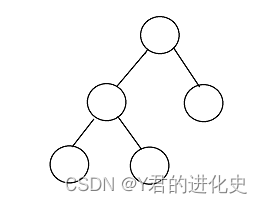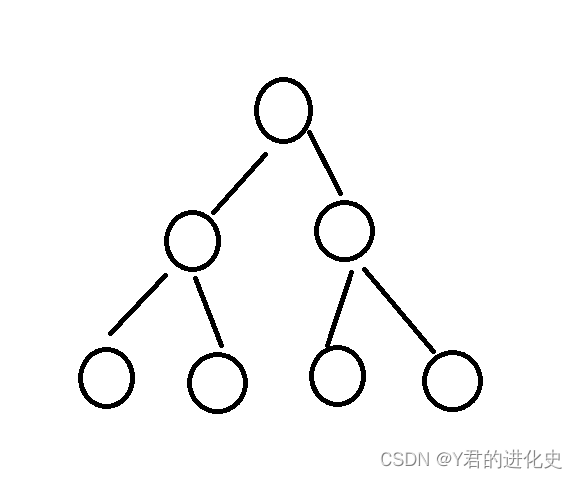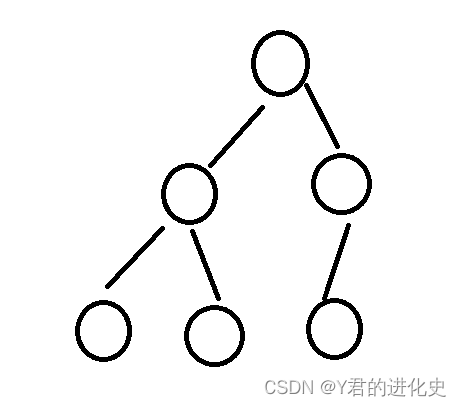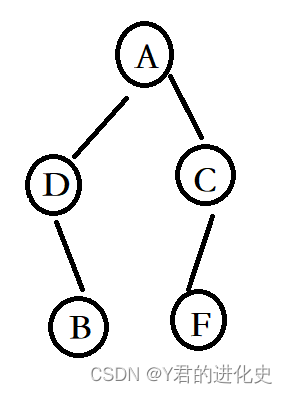前言
学习数据结构,二叉树是一大难点,也是一大重点,小伙伴们和我一起看看二叉树的知识吧!
本文代码是Java。
目录
一、什么是二叉树
二叉树是指只有一个根节点并且只有两个孩子节点的树。
例如:
二叉树中有两种特殊的二叉树,分别是满二叉树和完全二叉树。
- 满二叉树:
一个二叉树,如果每一个层的结点数都达到最大值,则这个二叉树就是满二叉树。
2.完全 二叉树:
一棵深度为k的有n个结点的二叉树,对树中的结点按从上至下、从左到右的顺序进行编号,如果编号为i(1≤i≤n)的结点与满二叉树中编号为i的结点在二叉树中的位置相同,则这棵二叉树称为完全二叉树。
注意事项:
1.一棵n个结点的树有n-1条边;
2.满二叉树的层数为k,则结点总数为(2^k)-1;
3.若根节点的层数为1,则非空二叉树的第i层最多(2^(i-1))-1个结点;
4.叶子节点n0,度为2的结点n2,则n0=n2+1,任何二叉树都满足这个特性;
5.具有n个结点的完全二叉树的深度k为log2(n+1)向上取整;
6.对于完全二叉树,
- 当根节点为0时,已知父节点为i,则左孩子节点为2i+1,右孩子节点为2i+2;
- 当根节点为1时,已知父节点为i,则左孩子节点为2i,右孩子节点为2i+1;
二、二叉树的遍历
以该二叉树为例子:
(一)前序遍历
前序遍历始终遵守 根节点 -> 左节点 -> 右节点的规律;
例如此二叉树通过前序遍历得出的顺序是:ADBCF.
144. 二叉树的前序遍历 - 力扣(Leetcode)
递归版本:
class Solution { public List<Integer> preorderTraversal(TreeNode root) { func(root); return list; } List<Integer> list = new ArrayList<>(); public void func(TreeNode root){ if(root == null){ return; } list.add(root.val); func(root.left); func(root.right); } }
非递归版本:
class Solution { public List<Integer> preorderTraversal(TreeNode root) { List<Integer> list = new ArrayList<>(); Stack<TreeNode> stack = new Stack<>(); TreeNode tmp = null; while(!stack.empty() || root!=null){ while(root != null){ stack.push(root); list.add(root.val); root = root.left; } root = stack.pop(); root = root.right; } return list; } }
(二)中序遍历
中序遍历始终遵守 左节点 -> 根节点 -> 右节点的规律;
例如此二叉树通过中序遍历得出的顺序是:DBAFC.
递归版本:
class Solution { public List<Integer> inorderTraversal(TreeNode root) { func(root); return list; } List<Integer> list = new ArrayList<>(); public void func(TreeNode root){ if(root == null){ return; } func(root.left); list.add(root.val); func(root.right); } }
非递归版本:
class Solution { public List<Integer> inorderTraversal(TreeNode root) { List<Integer> list = new ArrayList<>(); Stack<TreeNode> stack = new Stack<>(); while(!stack.empty() || root!=null) { while(root != null){ stack.push(root); root = root.left; } root = stack.pop(); list.add(root.val); root = root.right; } return list; } }
(三)后序遍历
后序遍历始终遵守 左节点 -> 右节点 -> 根节点 的规律;
例如此二叉树通过后序遍历得出的顺序是:BDFCA.
递归版本:
class Solution { public List<Integer> postorderTraversal(TreeNode root) { func(root); return list; } List<Integer> list = new ArrayList<>(); public void func(TreeNode root){ if(root == null){ return; } func(root.left); func(root.right); list.add(root.val); } }
非递归版本:
class Solution { public List<Integer> postorderTraversal(TreeNode root) { List<Integer> list = new ArrayList<>(); Stack<TreeNode> stack = new Stack<>(); TreeNode tmp = null; while(!stack.empty() || root != null){ while(root != null){ stack.push(root); root = root.left; } root = stack.pop(); if (root.right == null || root.right == tmp) { list.add(root.val); tmp = root; root = null; } else { stack.push(root); root = root.right; } } return list; } }
(四)层序遍历
层序遍历始终遵守 从根节点开始遍历,一层一层往下遍历 的规律;
例如此二叉树通过层序遍历得出的顺序是:ADCBF.
代码:
class Solution { public List<List<Integer>> levelOrder(TreeNode root) { Queue<TreeNode> queue = new LinkedList<>(); List<List<Integer>> list = new LinkedList<>(); if(root != null){ queue.offer(root); } while(!queue.isEmpty()){ List<Integer> list1 = new LinkedList<>(); int size1 = queue.size(); while(size1-- > 0){ root = queue.poll(); list1.add(root.val); if(root.left != null){ queue.offer(root.left); } if(root.right != null){ queue.offer(root.right); } } list.add(list1); } return list; } }
(五)依据前序遍历和中序遍历求二叉树
105. 从前序与中序遍历序列构造二叉树 - 力扣(Leetcode)
class Solution { public TreeNode buildTree(int[] preorder, int[] inorder) { if(inorder == null){ return null; } return buildTreeChild(preorder,inorder, 0, inorder.length-1); } int pre = 0; public TreeNode buildTreeChild(int[] preorder, int[] inorder, int form, int end){ if(form > end) return null; //if(pre >= preorder.length) return null; TreeNode tmp = new TreeNode(preorder[pre]); int i = findTree(inorder, preorder[pre],form,end); pre++; tmp.left = buildTreeChild(preorder,inorder, form, i-1); tmp.right = buildTreeChild(preorder,inorder, i+1, end); return tmp; } public int findTree(int[] inorder,int k, int index, int end) { for(int i = index; i<= end; i++){ if(inorder[i] == k){ return i; } } return -1; } }
(六)依据中序遍历和后序遍历求二叉树
106. 从中序与后序遍历序列构造二叉树 - 力扣(Leetcode)
class Solution { public TreeNode buildTree(int[] inorder, int[] postorder) { if(inorder.length == 1) return new TreeNode(inorder[0]); return buildTreeChild(inorder, postorder, 0, inorder.length-1, postorder.length-1); } int i = 0; public TreeNode buildTreeChild(int[] inorder, int[] postorder, int form, int end, int len){ if(form > end) return null; if(i > len) return null; TreeNode tmp = new TreeNode(postorder[len-i]); int index = findTree(inorder, postorder[len-i],form,end); i++; tmp.right = buildTreeChild(inorder, postorder, index+1, end, len); tmp.left = buildTreeChild(inorder, postorder, form, index-1, len); return tmp; } public int findTree(int[] inorder, int key, int form, int end){ for(int i = form; i <= end; i++){ if(inorder[i] == key) return i; } return -1; } }
结语
关于二叉树的知识点还有很多,例如红黑树、AVL树……
我们下期再见!
这篇博客如果对你有帮助,给博主一个免费的点赞以示鼓励,欢迎各位🔎点赞👍评论收藏⭐,谢谢!!!




